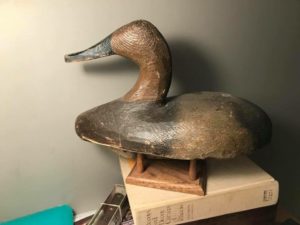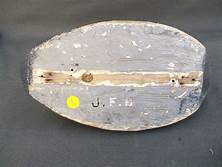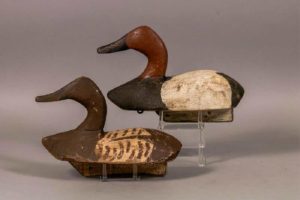A Decoy Corner Article
By Bruce Urben, President
Photo credit: decoysforsale.com
Duncan Joseph Ducharme was born February 14, 1912 in St. Ambrose, Manitoba, Canada. He was the son of Joseph M. Ducharme and Eloiza Lepinee and lived in St. Ambrose his entire life. Duncan was married to Caroline Ducharme nee Piche. Duncan was a hunter, trapper and Master Decoy Carver.
Duncan initially carved decoys for his own family’s use while they hunted on the Delta marsh and Lake Manitoba. Duncan later began carving decoys for James Ford Bell (the founder of General Mills Co. and instrumental in the establishment of the Delta Waterfowl Research station) for his hunting camp at the Delta Marsh on the south end of Lake Manitoba from 1930-1960. Ed Ward was the manager of Bell’s duck camp and his son, Peter, was a trained artist. Ed hired Duncan to carve decoy rigs for Bell’s camp. Many Ducharme decoys can be found with JFB carved into the bottom, or Bell branded in the bottom. Other late decoys have Duncan’s brand on the decoy bottom.
Duncan carved mainly diver decoys, and became widely known for his realistic looking canvasbacks. His decoy bodies were carved from white cedar and the heads from white pine. None of his decoys were hollowed! Most of his decoys had a steeply angled, pointed breast and rump. It looked as though his decoys were carved backwards for some reason, as the bodies were almost teardrop shaped. Some call the Delta Marsh shape “clunky” or “folky”, but they are built very strong to withstand hunting abuse. The heads are nearly centered on the body and most have no eyes. The heads have a strong bill and neck while others have what some call a “horse head”, with finer bill carving and rounded cheeks. All his heads are attached with a dowel through the top of the head and terminating in the bottom of the decoy. Ducharme decoys have beautiful curves and many say they have the best depiction of a canvasback on the water. The paint scheme was simple when done by Duncan, but many of his decoys were painted by Peter Ward who was a superb artist.
The keels on Ducharme’s are quite large, primarily made of wood with a lead strip attached to the bottom. Some of his later decoys had a specially made metal keel. The keels had to be large and heavy to adequately upright the decoy. All of Duncan’s decoys were made for working on the Delta Marsh. I have not yet seen a decorative Ducharme decoy.
Ducharme decoys are in relatively high demand by collectors. A pair of Ducharme canvasbacks were sold for $950 at an auction in 2019. Several can still be found online for reasonable collector prices at $500-$600. While the Ducharme style is unique, his canvasbacks look great on the water as well as on the shelf. I know many of his decoys are still being used today, which may explain why few are available on the secondary market.
Duncan died on July 6, 1972 and is buried in the St. Ambroise Cemetery.



